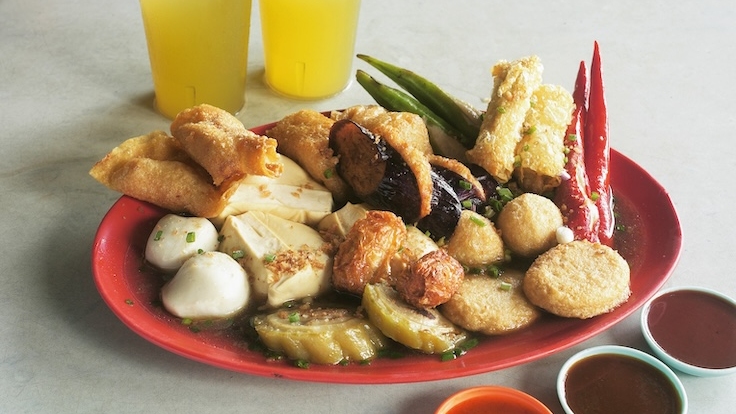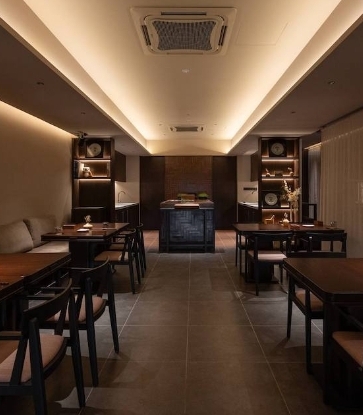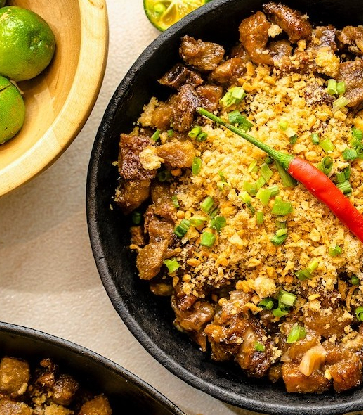Yong tau foo (Chinese: 釀豆腐) is one of the best-known dishes concocted by the Hakka-Chinese people. The name itself, pronounced “nyiong tiew foo” in Hakka, literally translates as “stuffed tofu.” The dish refers to a collection of tofu or vegetable morsels stuffed with fish paste, ground pork, or a mixture of both. The versatility of yong tau foo sees the dish being served fried, in soups, or braised.

The History and Origins of Yong Tau Foo
Like other Han Chinese, the Hakkas are thought to have come from the cradle of Chinese civilisations at the Central Plains along the Yellow River. Centuries of migration southward, to escape war and conflict, brought the Hakkas to areas that now constitute modern-day Guangdong and Fujian. Here, the Hakkas had to settle in the less-desirable hilly terrains, away from the already-inhabited fertile lowlands in the coastal areas. Consequently, the Hakkas were often called by other Chinese as “ke jia” (Chinese: 客家), which translates literally as “guest people.” With no homeland of their own, and facing hostility externally, the Hakkas frequently relocated from one place to another.

Yong tau foo reflects the adaptability of the Hakka people and was thought to have come about due to the scarcity of wheat flour needed to make dumpling skin or wrappers, as the Hakkas migrated southwards. So, the ever-versatile Hakkas made use of tofu as a substitute and stuffed it with minced meat. Then, as they settled in coastal provinces like Fujian and Guangdong — areas with bountiful seafood — they incorporated ground fish into their erstwhile meat-based yong tau foo filling.
The Popularity of Yong Tau Foo in Malaysia and Singapore
Compared to the Cantonese or Teochew-style minced fish filling, which makes use of only fish meat that has been blended to a smooth paste, the Hakka yong tau foo utilises a mixture of minced fish meat and ground pork, giving the resultant blend a coarser texture and a richer, meatier flavour. This filling is stuffed in tofu, bitter gourd, eggplant, shitake mushrooms, chilli peppers, and okra; or made into dumplings using large wantan wrappers.

In Singapore, yong tau foo is one of the most common everyday street food dishes, and it can be readily found in most hawker centres and food courts. Usually, the various yong tau foo items are attractively arrayed on brightly lit display counters, and customers will be given large bowls and metal tongs to make their own selection. Nothing entices over-ordering (by a hungry diner) more than a tempting buffet spread of colourful, delicious morsels — every item seems to be screaming “Pick Me!”. Wholesome bunches of green vegetables complete the ensemble: choy sum, spinach, lettuce, broccoli — all healthy options for one’s meal selection.

Once the customer has made his/her choice, the bowl will be handed over to the counter staff, who will pass it on to the cook, who will blanch the selected items in a gently boiling clear broth. The items being cooked will lend their respective flavours to the soup — the beauty of yong tau foo is such that, despite the array of differing items being cooked together, the overall taste and flavour of the dish remain light, due to the brief cooking time.

Yong tau foo is also a popular repast in Kuala Lumpur — widely available, but especially in the Hakka-dominated Ampang district. Over there, customers are given order chits that allow them to tick off their selected items. The cooking style involves first lightly deep-frying the yong tau foo before they are served either dry, lightly drizzled with a savoury broth, or in a clear soup. These will be accompanied by spicy chilli and sweet red fermented bean sauces on the side. Kuala Lumpur diners also customarily order rice or noodles to accompany their yong tau foo for a complete meal.

In Penang, with its largely Hokkien populace but a street food culture dominated by the Teochews, the Hakka minority there shows its adaptability once again, making use of ingredients that are readily available to construct their version of yong tau foo.
The Penang-style yong tau foo is replete with pig’s intestines, stomach, spleen, and other offal, mirroring the composition of Teochew kway chiap, but served in the trademark light broth of the Hakkas, and accompanied by the ubiquitous stuffed tofu and vegetables. Porkier than yong tau foo renditions elsewhere and utterly delicious, it is a culinary master stroke and a win-win situation for everyone. Similar to Singapore, and unlike in Kuala Lumpur, Penangites do not require steamed rice or noodles to complete their yong tau foo meal.
Wherefore art thou, yong tau foo?
Yong tau foo’s popularity amongst the dining public lies in its wholesome, healthy image — one that spotlights tofu and fresh vegetables, and a sparing use of meats. It also emphasises light broths over heavy sauces, and boiling over pan-frying or deep-frying in grease and fats.
History shows us how successful the Hakkas are, rising above adversity to chart their own future. In a way, the evolution of yong tau foo depicts the journey of the indomitable Hakkas themselves — practical, adaptable, and always willingly ready to absorb positive, external influences. The whole really is greater than the sum of its parts here.
Where to enjoy Yong Tau Foo in Singapore:
Loong Kee Yong Tau Fu (Selected, MICHELIN Guide Singapore 2024)
Yong Xiang Xing Tou Fu (Selected, MICHELIN Guide Singapore 2024)
Where to enjoy Yong Tau Foo in Kuala Lumpur:
Hor Poh Cuisine (Bib Gourmand, MICHELIN Guide Kuala Lumpur & Penang 2024)




















